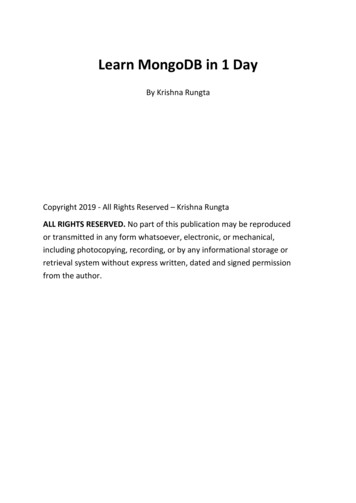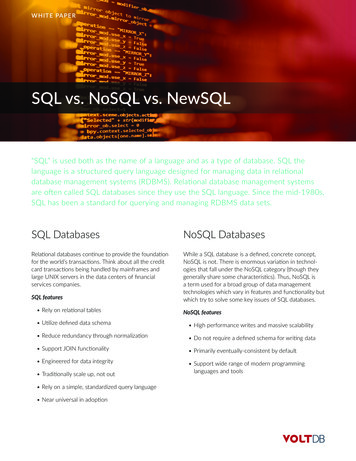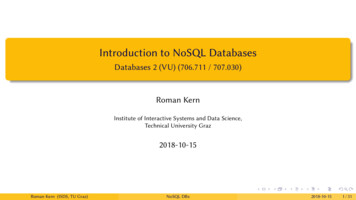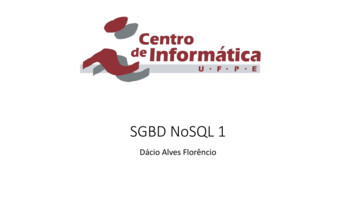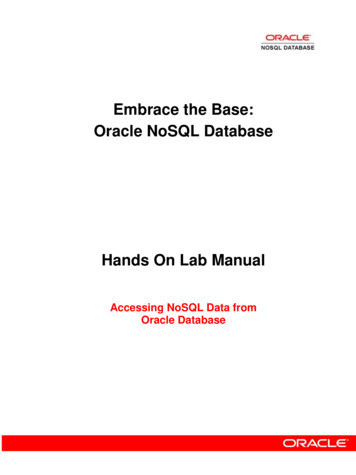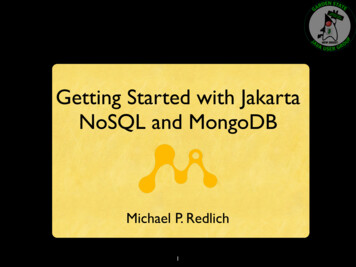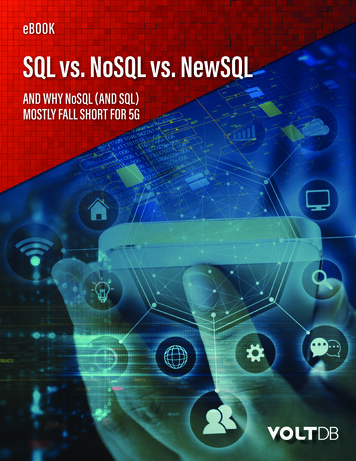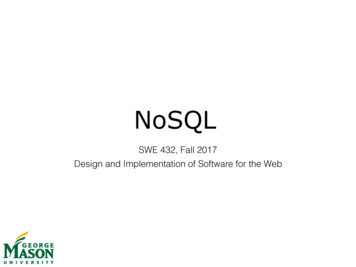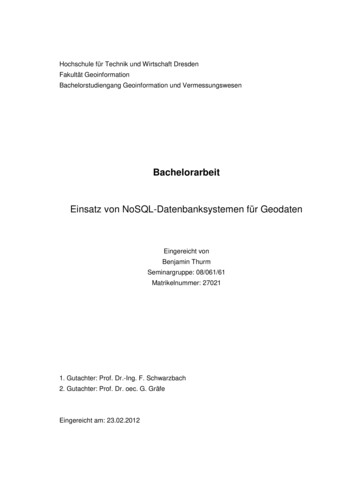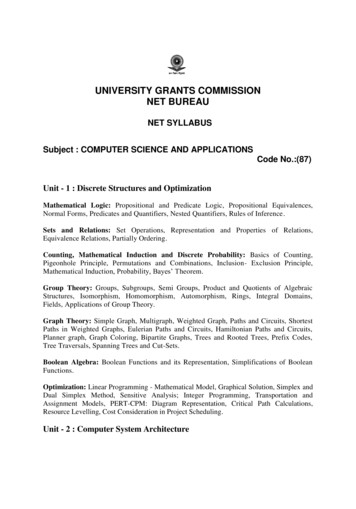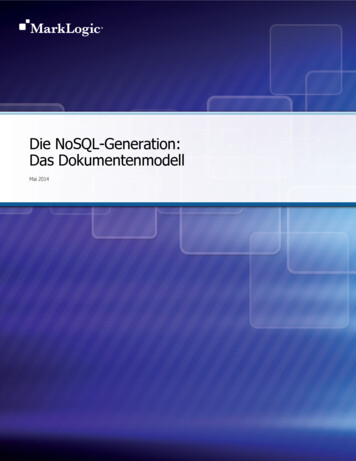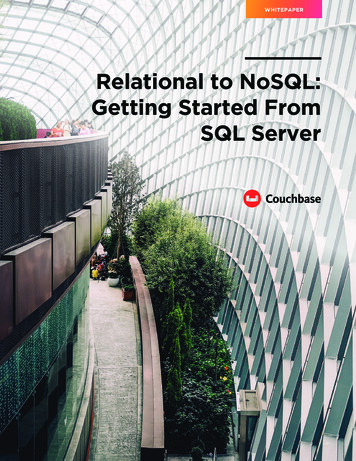
Transcription
WHITEPAPERRelational to NoSQL:Getting Started FromSQL Server
Why the shift to NoSQL?As enterprises modernize, teams have to build and maintainCouchbase has enabled hundreds of enterprises, growthapplications more rapidly and at greater scale. Applicationscompanies, and startups to deploy NoSQL for bettermust be resilient and available whether their clients areflexibility, fast performance, and affordable costs. Theweb, mobile, or the Internet of Things (IoT). If any of thesegoal of this paper is to help you introduce NoSQL intochannels fail, customers go elsewhere. Today, enterprisesyour organization by highlighting lessons learned fromin every industry from travel, to technology, to retail andteams that successfully adopted NoSQL. We’ll explore keyservices are leveraging NoSQL database technology forconsiderations and strategies for transitioning to NoSQL,more agile development, reduced operational costs, andin particular, to a document database (Couchbase Serverscalable operations. For many, the use of NoSQL started withor Couchbase Capella DBaaS), with tips for moving froma cache, proof of concept (POC), or small application, thenSQL Server and other relational databases. Note, there areexpanded to targeted mission-critical applications. NoSQLuse cases in which NoSQL is not a replacement for, but ahas now become a foundation for modern web, mobile, andcomplement to, existing infrastructure, facilitating the use ofIoT application development.polyglot persistence.Some of the largest internet and enterprise companies areWe’ll start with recommendations for identifying andusing NoSQL technology to deploy their mission-criticalselecting the right application. Next, we’ll cover strategiesapplications. Examples include:for modeling relational data as documents, how to access Gannett publisher of USA Today and 90 mediaproperties, replaced relational database technologywith NoSQL to power its digital publishing platformthem within your application, and how to migrate datafrom a relational database. Finally, we’ll highlight thebasics of operating a NoSQL database in comparison toa relational database. Marriott deployed NoSQL to modernize its hotelreservation system that supports 38 billion inannual bookings FHL Bank Topeka integrates NoSQL with SQL Serverto speed up access to customer financial data for its770 member banks Cars.com with over 30 million visits per month, replacedSQL Server with NoSQL to store customer and vehicle dataNoSQL has become a foundation for modern web,mobile, and IoT application development.At Couchbase, we’ve enabled hundreds of enterprises,as well as numerous growth companies and startups,to deploy NoSQL for better agility, performance, andlower costsWHITEPAPER2
Top 5 reasons companies replaceSQL Server with a NoSQL databaseIf you’re running into limits with Microsoft SQL Server (orother relational databases) – either in terms of rising costsand complexity, or in scaling to meet your requirements –this is the time to evaluate a NoSQL database.Many companies have chosen Couchbase Server eitherto augment Microsoft SQL Server and other relational databases, or in some cases replace them.Their top 5 reasons:1. Flexibility to scale3. Up to 40x more affordableWhether running on three nodes or hundreds – in theWith subscriptions based on the number of instances,cloud or on-prem – Couchbase Server is based on aCouchbase typically costs 5-40x less than SQL Server anddistributed architecture to scale on commodity hardwareits per-core based licensing – especially on servers withwith ease, regardless of the operating system. Couchbasemany cores.Capella provides a fully hosted, managed cloud DBaaS tomake scaling and operations even easier.4. FamiliarityCouchbase fuses the best of relational with the best of2. Faster performanceNoSQL. Data is stored as flexible JSON, but can be queriedCouchbase Server features an integrated cache, memory-with SQL . With ACID transactions also possible, youroptimized indexes, and memory to-memory replication toteam will have a running start in modernizing.deliver consistent, high throughput with submillisecondresponse time, at any scale.5. Future-proofCouchbase supports the growth of use cases. While youmay start using Couchbase for its high-performancecaching capabilities, as your application expands, you canuse built-in query, text search, mobile, analytics, syncing,and more as needed.WHITEPAPER3
Why the shift to NoSQL?Many enterprises have successfully introduced NoSQL byidentifying a single application or service to start with. Itcould be a new one that is being developed, or an existingSome common examples of good usecases for NoSQL: Product catalog serviceapplication that’s being refactored. Examples include: A high performance, highly available caching service A small, independent application (or microservice)with a narrow scope Asset tracking service Content management service Application configuration service A logical or physical service within a large application Customer management service A global service that powers multiple applications File or streaming metadata serviceacross multiple regionsIdeal candidates have one or more of thefollowing characteristics or requirements: Need to modify the data model to respond to changeMany enterprises have successfully introducedNoSQL by identifying a single application or serviceto start with.frequently – e.g., to accommodate new preferences,new social media accounts, etc.) Ability to read and write JSON documents (semistructured data) to/from web and mobile clients Provide low latency, high throughput access to datae.g., users expect interactions to be instant, andwaiting negatively impacts the experience Support thousands to millions of concurrent users –e.g., the number of users rapidly increases, sometimesexponentially, as when content goes viral Support users in any country or region – they’reeverywhere Support users and be available 24x7 Store terabytes of data Deploy in multiple data centers with an active/activeconfiguration Build enterprise applications – a series of applicationswith constantly changing schema requirements,complex or unstructured dataWHITEPAPER4
Modeling and migrating your dataCouchbase Server is a document database – data is stored in JSON document collections, instead of tables. While relationaldatabases rely on an explicit predefined schema to describe the structure of data, document databases do not – JSONdocuments are self-describing. As such, every JSON document includes its own flexible schema, and it can be changed ondemand by changing the document itself.Figure 1: Relational schema and data vs. self-describing JSON documentsIt’s important to understand that JSON documents are not limited to primitive fields. They can include arrays and objects,and they can be nested, just like applications. For this reason, there is no “impedance mismatch” between applicationobjects and JSON documents. No complex object-relational mapping (ORM) solution is required.Figure 2: Multiple tables vs. nested data with JSON documentsWHITEPAPER5
Just as every row in a table requires a primary key, every document requires an object ID. Many applications rely on relationaldatabases to automatically generate the primary key (for example, with the IDENTITY columns in Microsoft SQL Server).Document databases can use unique keys like UUID/GUID, but applications can also use natural keys where possible.In a relational database, primary keys are defined per table. It’s not uncommon for the primary key of different rows in differenttables to have the same value. After all, a row is identified by its table and primary key. However, document databases donot store documents in tables; in Couchbase Server, they’re stored in collections (which are then stored in scopes and thenbuckets). You can store any type of document within a collection, but typically you will store similar types of documents withinthe same collection (i.e., very similar to using a relational table).ClusterBucketCouchbase Server is a documentdatabase – data is stored in JSONdocuments, not in tables.ScopeCollectionEvery JSON document includes itsown flexible schema, and it can bechanged on demand by changingthe document itself.DocumentsFigure 3: Couchbase Server – Documents are stored in buckets, buckets arepartitioned and ditributed aross nodes automatically.The benefit of using natural keys with a document database is that a document can be identified by an object ID, even if thecollection stores different types of documents.For example, consider a single collection with blogs, authors, and comments stored in separate osql fueled hadoopblog::nosql fueled hadoop::commentsThese object IDs not only enable the bucket to store related documents; they’re also human readable, deterministic, andsemantic. In addition, an application can construct these keys easily to fetch or query using them. Even if you decided to putthese four documents into four separate buckets, these keys will still be beneficial.A document can be modeled after a row (flat), or it can be modeled after related rows in multiple tables (nested). However,documents should be modeled based on how applications interact with the data. While some documents may contain nesteddata, others may reference it.WHITEPAPER6
Figure 4: Related vs. nested JSON documentsIn the absence of tables, applications can benefit from includingNOTE: Couchbase Server supports atomica field in documents that identifies the type of document. In thecounters, and like IDENITY columns infigure 4 example, there are user, address, and account types. TheMicrosoft SQL Server, they can be usedtype field can then be indexed to improve query performance whento automatically generate object IDs formultiple types of documents are stored within the same bucket.documents. In addition, counters can beincremented by any amount. LikeIDENTITY columns in Microsoft SQLServer, counters can be incremented byany number, for example, 50.In relational databases, children reference their parents via foreignkeys. However, in document databases, parents are able toreference their children when appropriate. That’s because, whilea field in a row can only contain a single value, a field within adocument can contain multiple values. In the example of a relatedMIGRATION TIP: Create object IDs formodel (figure 4), the addresses and accounts fields contain multipledocuments that include the row’s primaryobject IDs – one for each address. However, the shipping and billingkey. For example, if the primary key of aobject IDs are not required – they are deterministic.row in the products table is 123, thedocument ID is product::123. However, ifyou are putting documents in a productcollection, you may want to omit “product::”to save memory and disk space.A document can contain fields, objects, lists, and arrays. In theexamples above, the addresses field contains a list of addressesor references to address. The accounts field contains an array ofaccounts or references to accounts.WHITEPAPER7
Reference or nest related data?There are two things to consider when deciding how to model related data:1. Is it a one-to-one or one-to-many relationship?2. How often is the data accessed?If it’s a one-to-one or one-to-many relationship (a child has one parent), it may be better to store the related data as nestedobjects. This approach results in a simple data model and reduces or eliminates the need to query multiple documents.However, if it’s a many-to-one or many-to-many relationship (a child has multiple parents), it may be better to store the relateddata as separate documents, which reduces or eliminates the need to maintain duplicate data.If a majority of the reads are limited to parent data (e.g., first and last name), it may be better to model the children (e.g.,addresses and accounts) as separate documents. This results in better performance, because the data can be read with asingle key-value operation instead of a query, and reduces bandwidth, because the amount of data being transferred is smaller.However, if a majority of the reads include both parent and child data, it may be better to model the children as nested objects.This approach results in great performance because the data can be read with a single key-value operation instead of a query.If a majority of the writes are to the parent or child, but not both, it may be better to model the children as separate documents.For example, if user profiles are created with a wizard – first add info, then add addresses, finally add accounts – or if a user canupdate an address or account without updating their info. However, if a majority of writes are to parent and child (both) – forexample, there’s a single form to create or update a user – it may be better to model the children as nested objects.When to nest? Considerations: One-to-one or one-to-many? Nest. Most reads are for parent and child together? Nest. Many-to-one or many-to-many? Don’t nest. Most writes are for parent or child? Don’t nest. Most reads are for parent data? Don’t nest. Most writes are for parent and child together? Nest.Finally, it may be better to model children as separate documents to reduce document size and write contention. For example,the number of reviews on a product may grow indefinitely. If they were embedded, the size of the product document couldbecome excessive, resulting in slower reads. Consider a blog and comments. When a blog is first published, there may be alot of readers posting comments. If the comments are embedded, many concurrent users will try to update the same blogdocument at the same time, resulting in slower writes. A good compromise may be to store comments as separate threads –a document for every top-level comment that embeds all replies.Figure 5: Different documents of the same type can have different schemaWHITEPAPER8
Performing a migration?The easiest and fastest way to get started is to export your relational data to CSV files, andNoSQL databases provideimport them into Couchbase Server. This may not represent the final data model, but it willdata access via key-valueenable you to start interacting with Couchbase Server right away. Couchbase Server includesAPIs, SQL , full-texta command-line utility, cbimport, for importing data in CSV files.search, and more.NOTE: Same object,different structure?As illustrated in figure 5,it’s possible for the samefield or object to havea different structure indifferent documents. cbimport csv -c couchbase://127.0.0.1 -u Administrator -p password -bdefault --scope collection-exp myscope.products -d file:///products.csv -g%id% -t 4Understanding your access patternsNoSQL databases provide data access via key-value APIs, SQL query APIs, or SDKs.The key-value API provides the best performance – since it will often be direct from an inmemory cache. The query API or language provides the most power and flexibility – enablingapplications to sort, filter, transform, group, and combine documents. Queries to Couchbase aredone using SQL, just like in a relational database (with extensions for JSON, hence “SQL ”).Key valueThe key-value API can provide a great deal of data access without the need to perform queries. In the example below, once youhave the object ID of the user profile document, you can figure out what the object IDs of the address and account documents are.WHITEPAPER9
QueryThe query API or language, combined with proper indexing, can provide a great deal of powerand flexibility without sacrificing performance. Couchbase Server provides a SQL implementationcalled N1QL, which extends SQL to JSON documents. N1QL also has support for ANSI joins making iteasier for developers to apply their SQL knowledge to develop applications within Couchbase.Couchbase Server’s implementationof the SQL standard is calledN1QL, which extends SQL toJSON documents.While one of the benefits of storing related data as separate documents is the ability to read a subset of the data (e.g., shippingaddress), the same thing can be accomplished with a query API or language when related data is nested. For example, to readthe billing address from a user profile document that stores all related data as nested objects.WHITEPAPER10
In addition, while one of the benefits of storing related data as nested objects is the ability to access all data with a single read,the same thing can be accomplished with a query API or language when related data is stored as separate documents. Forexample, to read the user profile and accounts and addresses when they are stored as separate documents.The query language can be used to perform CRUD operations as an alternative to the key-value API. This enables applicationsbuilt on top of a relational database to migrate all data access by replacing SQL statements with SQL statements. One ofthe advantages of performing CRUD operations with SQL have the ability to perform partial updates:N1QL abstracts the data model from the application model. Regardless of how data is modeled in the database, applicationscan query it any way they need to by joining documents, nesting and unnesting them, and more. It provides developers withthe flexibility they need to model data one way and query it in many.WHITEPAPER11
Indexing your dataQuery performance can be improved by indexing data. NoSQL databases support indexes to varying degrees– Couchbase Serverincludes comprehensive indexing support. Below are some indexing examples.A simple index on the user status:NoSQL databases support indexes toINDEXvarying degrees – Couchbase ServerCREATE INDEXON123user statususers(status);includes comprehensive indexing support.QUERY123SELECT count(status)FROMusersWHERE status “Platinum”;A composite index on user status and shipping state:INDEX123CREATE INDEX user status stateONusers(status, WHERElastName, firstNameusersstatus “Platinum” ANDaddresses.shipping.state “CA”;A functional index on shipping state:INDEX123CREATE INDEX user accountsONusers(count(accounts));QUERY123SELECT lastName, firstNameFROMusersWHERE count(accounts) 3;WHITEPAPER12
A partial index on user billing state of users with a Visa credit card:INDEX123CREATE INDEX user account counts.type “VISA”;QUERY1234SELECTFROMWHEREUSE INDEXlastName, firstNameusers(addresses.billing.state) “CA”(user accounts visa USING GSI);:Couchbase Server supports index intersection. A query can scan multiple indexes in parallel. As a result, it may not benecessary to create multiple indexes that include the same field, thereby reducing both disk and memory usage. You canalso index a large number of documents and horizontally scale out an index as needed. The system will transparentlypartition the index across a number of index nodes using hash partitioning and will increase the performance and datacapacity of the cluster. For more index examples please see the documentation here.WHITEPAPER13
Connecting to the databaseApplications access data in NoSQL databases via clients. Couchbase Server SDKs are all topology-aware clients (e.g., smartclients) available in many languages: Java, Node.js, PHP, Python, C, and more. These clients are configured in much the sameway JDBC/ODBC drivers are configured.Figure 6: Creating a connection to a relational database vs. Couchbase ServerA bucket is a higher-level abstraction than a connection,In addition, the cluster map enables operations teams toand a cluster can contain multiple buckets. In thescale out the database without impacting the application.example above, the application can access data in theRegardless of the number of nodes, the application sees ausers bucket. However, while key-value operations aresingle database. There are no application changes requiredlimited to the users bucket, SQL queries are not.to scale from a single node to dozens – the clients areCouchbase Server is a distributed database, butautomatically updated.applications do not have to pass in the IP address ofIn addition, with Couchbase Server, applications no longerevery node. However, they should provide more thanhave to rely on object-relational mapping frameworks forone IP address so that if the first node is unavailable ordata access, because there is no impedance mismatchunreachable, they can try to connect to the next node.between the data model and the object model. In fact,After the client connects to a node, it will retrieve thedomain objects are optional. Applications can interact withIP address of the remaining nodes.the data via document objects or by serializing domainCouchbase Server clients also maintain a cluster map,objects to and from JSON.which enables them to communicate directly with nodes.WHITEPAPER14
Figure 7: working with domain objects vs document objectsApplications access data in NoSQL databases via clients.It’s easy to serialize domain objects to and from JSON,and it may be helpful to do so for applications with aCouchbase Server’s topology-aware SDKs are availablecomplex domain model or business logic. However, forin many languages: Java, Node.js, .NET, PHP, Python, C,new applications or services, working with documentand more.objects will require less code and provide more flexibility –NOTE: In addition to the clients, there are supported,developers can change the data model without having tocertified JDBC/ODBC database drivers available forchange the application model. For example, you can add aCouchbase Server.new field to a form without changing application code.TransactionsSimilar to a relational database, Couchbase offers ACID transaction support. Transactions must be initiated by the CouchbaseSDK, and can include key-value operations and/or SQL operations.Transactions are not required when changing data in a single document structure as changes within a document are atomic. Whenarchitecting new data structures this should be taken into account as atomic changes to a single document are lighter weight.WHITEPAPER15
try{await transactions.RunAsync(async (ctx) {// 'ctx' is an AttemptContext, which permits getting, inserting,// removing and replacing documents, along with committing and// rolling back the transaction.// . Your transaction logic here .// This call is optional - if you leave it off, the transaction// will be committed anyway.await reAwait(false);}catch (TransactionCommitAmbiguousException e){// The application will of course want to use its own logging rather// than ion possibly committed");Console.Error.WriteLine(e);}catch (TransactionFailedException e){Console.Error.WriteLine("Transaction did not reach commit point");Console.Error.WriteLine(e);Figure 8: Transactions using the .NET APIWHITEPAPER16
Installing and scaling your databaseOne of the key advantages driving the adoption of NoSQL databases with a distributed architecture is their ability to scalefaster, easier, and at a significantly lower cost than relational databases. While most relational databases are capable ofclustering (e.g., Microsoft SQL Server), they are still limited to scaling up – failover clustering relies on shared storage whileAlways-on availability groups are limited to replication. As a result, more data requires a bigger disk, and more users requirea bigger server. The shared storage not only becomes a bottleneck, it becomes a single point of failure. In contrast, mostNoSQL databases are distributed to scale out – more data requires more disks, not a bigger one, and more users requiremore servers, not a bigger one.SCALESCALEUPUPSCALESCALEOUT AGELOCALSTORAGEDATABASE DATABASEINSTANCE CALSTORAGELOCALLOCALSTORAGE STORAGELOCALLOCALSTORAGE STORAGELOCALLOCALSTORAGE STORAGELOCALSTORAGELOCALLOCALSTORAGE STORAGEFigure 9: Scaling up vs. scaling outCouchbase Server’s topology-aware clients and consistent hashing distribute data within a cluster automatically. Data can bereplicated to one or more nodes to provide high availability, also automatically.L OCALS TOL OCA LST ORA G EL OCA LST ORA G EL OCA LST ORA G EL OCA LST ORA G ERA GL OCALS TOR A GLOCALSTORAGELOCALSTORAGEWHITEPAPER17
Installing Couchbase ServerOne of the key advantages driving adoption of NoSQLdatabases with a distributed architecture is their abilityto scale faster, easier, and at significantly lower costthan relational databases. NoSQL databases should bedeployed as a cluster to realize all of their benefits.Installing Couchbase Server requires little more thandownloading the install binary, running it, and configuringthe database via the web-based administrative console orCLI. It can also be installed via Docker.Perhaps the easiest way to get started is with Couchbase’sDatabase-as-a-Service (DBaaS), Couchbase Capella . Youcan start a free trial here.Couchbase delivered as a serviceWith Capella, database management (setup, ongoingoperations, and maintenance) is automated and streamlinedAPPso customers can focus on other areas like applicationdevelopment and improving time to market. KeyCouchbase SDKbenefits include:KeySFO MQ2Fully managed Automated setup, backups, upgrades, and ongoingCRC32management to deliver an always-on service, reducingHashing Algorithmyour operational efforts.CLUSTER MAPAutomated scaling in/out and up/down Easily add, remove, or change nodes to meet your cket7vBucket6vBucket1024needs. Couchbase rebalances your data. No applicationchanges needed.Single pane for multi-cluster, multi-region The Capella control plane manages data across clustersand across clouds, allowing you to be cloud-provideragnostic. It also provides tools for SQL access,Couchbase ClusterFigure 9: Topology-aware clients in Couchbase Serverdocument viewing, index creation, and full-text searchwithin the UI.High availability Capella guarantees the global reliability of your datathroughout regions and availability zones via nativereplication across geo-aware clusters, all day, every day.Self-monitoring, self-healing Capella proactively monitors clusters 24/7 to locate,assess, and resolve issues automatically.Security peace of mind In addition to SOC II compliance, Capella delivers endto-end encryption from the SDK to the disk and offersgranular role-based access control.WHITEPAPER18
Monitoring and managingyour deploymentIn addition to the administration console and APIs, Couchbase Server includes a number of command line tools toperform additional tasks such as, among others:Couchbase Server and Couchbase Capella includean integrated, comprehensive administrationconsole as well as REST and CLI APIs.While many relational and NoSQL databases requireseparate administration tools, Couchbase Server includes anintegrated, comprehensive administration console as well asREST and CLI APIs. cbbackupmgr – Full, cumulative, and incrementalbackup and restore cbcollect info and cbdstats – Gather node and clusterdiagnostics (280 metrics) cbq – Run SQL queries from the command line cbimport/cbexport – Transfer data to and from JSONor CSV filesThe administration console and the REST/CLI APIs enableadministrators to manage and monitor clusters, both smalland large, with minimal effort. Functionality enabled throughthe Couchbase admin console includes:Management, monitoring, and configuration Cluster/node/bucket/views Cross data center replication (XDCR) Database performance, network utilization,resource utilizationTasks Add and remove nodes Failover nodes Rebalance clusterConfiguration Authentication and authorization AuditingAuthentication and authorization Audit Monitor View and collect log informationWHITEPAPER19
Putting it all together:How to conduct a successful proof of concepts (POC)Now that you’re familiar with the key considerations and strategies for transitioningNow that you’re familiar withfrom a relational database to a NoSQL database – how to select an application, how tothe key considerations andmodel and access the data, and how to deploy the database – you’re ready to start astrategies for transitioningproof of concept.from a relational databaseto a NoSQL database,you’re ready to start aproof of concept.Couchbase solutions engineers have helped, and continue to help, many enterprisessuccessfully introduce NoSQL, from planning all the way to post-production. Weencourage everyone to start with a proof of concept.There are five steps to a successful proof of concept:1. Select a use case and application4. Identify the access patternsIt’s important to remember that the key to successfullyNext, identify how the data is used and then begin tointroducing a NoSQL database is to first identify anmodel it within a NoSQL database. This will depend veryappropriate use case and select an application. Try tomuch on how the application reads, writes, and finds data.find an application that can realize one or more of theThe data model can be optimized for different accessbenefits of a NoSQL database – better performance andpatterns. In addition, you have to choose the right datascalability, higher availability, greater agility, and/oraccess method – key-value operations, queries, full-textimproved operational management.search, – for the right data access pattern – basic read/2. Define the success criteriawrite operations, queries, or aggregation and reporting.It may be difficult to move beyo
Many companies have chosen Couchbase Server either to augment Microsoft SQL Server and other relational da-tabases, or in some cases replace them. Their top 5 reasons: 1. Flexibility to scale Whether running on three nodes or hundreds - in the cloud or on-prem - Couchbase Server is based on a distributed architecture to scale on commodity .
